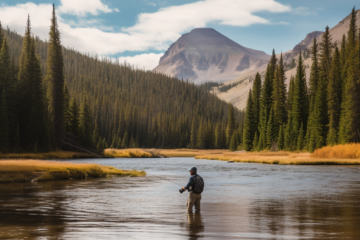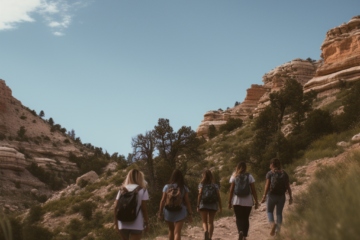Geocaching, a modern-day treasure hunt using GPS technology, has revolutionized outdoor adventures. Participants navigate to specific coordinates to uncover hidden containers and treasures worldwide. This activity combines the thrill of exploration with problem-solving skills, making it an exciting pastime for all ages. Dating back to the year 2000 when GPS became accessible for civilian use, geocaching has grown into a global phenomenon with millions of active caches waiting to be discovered in urban and wilderness settings alike.
Geocaching Basics
Finding Geocaches
Geocaching is like a modern-day treasure hunt. Players use GPS coordinates to locate hidden containers known as geocaches. These can be found in various places worldwide, from urban parks to remote hiking trails. Each cache description provides clues and details about the geocache’s size and difficulty level.
Explorers of all ages enjoy the thrill of discovering these hidden treasures. Some geocaches are tiny, like a film canister, while others can be large enough to hold small toys or trinkets for trading with fellow geocachers. The excitement lies in deciphering clues, following coordinates precisely, and uncovering the well-concealed caches.
Types of Geocaches
There are different types of geocaches that offer unique challenges for players:
-
Traditional caches: The most common type where players find a container at given coordinates.
-
Multi-caches: Require finding multiple locations before reaching the final cache.
-
Mystery or Puzzle caches: Solve puzzles or riddles to reveal the cache location.
-
EarthCaches: Educational caches highlighting geological features instead of physical containers.
Each type presents its own set of challenges and adventures for geocachers. Whether it’s solving brain-teasing puzzles or learning about natural landmarks through EarthCaches, there’s something for everyone in this engaging outdoor activity.
Benefits of Geocaching
Engaging in geocaching offers numerous benefits beyond just finding hidden treasures:
-
Encourages outdoor exploration and physical activity.
-
Enhances navigational skills using GPS devices.
-
Fosters teamwork when searching for geocaches with friends or family members.
Geocaching not only promotes an active lifestyle but also helps individuals develop problem-solving abilities while having fun outdoors. It’s a fantastic way to bond with loved ones and create lasting memories together amidst nature’s beauty.
Getting Started with Geocaching
Accessing Geocache Locations
To begin geocaching, the first step is to download a geocaching app on your phone. These apps provide access to various geocache locations where hidden treasures are waiting to be found. By using these apps, you can easily locate different sites where geocaches are placed by other cachers.
When you open the app, it will show you nearby geocaches based on your current location. You can then choose a cache that interests you and navigate towards its coordinates using the app’s map feature. This process makes finding hidden treasures an exciting adventure while exploring new places in your area.
-
Pros:
-
Easy access to numerous geocache locations.
-
Convenient navigation through maps provided by the app.
-
Cons:
-
Reliance on GPS signal for accurate location tracking.
-
Limited functionality in areas with poor network coverage.
Creating a Free Account
After downloading the app, creating a free account on a geocaching website is essential for tracking your progress as a geocacher. These accounts allow you to log your finds, connect with other geocachers, and participate in challenges or events organized within the community.
By having an account, you gain access to additional features such as saving favorite caches, receiving notifications about new caches in your area, and earning achievements based on your activity. It also enables you to contribute to the community by sharing information about newly discovered caches or reporting any issues like vandalism or misplaced caches.
-
Go to a geocaching website.
-
Click on “Sign Up” or “Create Account.”
-
Fill out the required information (username, email address).
-
Verify your account through email confirmation.
-
Start logging your finds and engaging with fellow cachers online.
Types of Geocaches
Traditional Geocaches
Traditional geocaches are the most common type you’ll encounter in geocaching. These caches typically include a logbook for you to sign your name and date when you find them. Traditional geocaches often contain small items that you can trade with something of equal or greater value.
When searching for traditional geocaches, keep in mind that they are usually hidden well but not too difficult to locate once you’re in the general vicinity. Some examples of items found in traditional caches include toys, stickers, keychains, or other trinkets. Remember always to follow the “take something, leave something” rule when trading items.
Mystery Caches
Mystery caches add an extra layer of challenge to geocaching by requiring solvers to decipher clues or complete puzzles before revealing the final cache location. These types of caches test your problem-solving skills and creativity as you work towards uncovering the hidden treasure.
When tackling mystery caches, be prepared for brain-teasing riddles, math problems, or even tasks that involve visiting multiple locations to gather information needed to crack the code leading to the cache’s whereabouts. Mystery caches offer a thrilling experience for those seeking a mental challenge while out on a treasure hunt adventure.
Multi-Caches
In multi-caches, adventurers must navigate through various stages or waypoints before reaching the final cache location. Each stage provides clues leading participants closer towards their ultimate goal – finding and logging their discovery at the final hideaway spot.
Multi-caches may take seekers on an exciting journey through different areas as they collect information from each waypoint until they finally piece together all elements needed to pinpoint where the final cache is concealed. This type of cache offers a unique exploration opportunity by guiding players on a mini-adventure within their larger quest for hidden treasures.
Technology in Geocaching
Essential Tools
GPS devices and smartphone apps play a crucial role in geocaching. They help enthusiasts navigate accurately to the hidden treasures. By utilizing gps devices or smartphone, geocachers can pinpoint the exact locations of caches, making the adventure more exciting.
Online platforms are also essential for geocachers. These platforms provide detailed information about each cache, including ratings for difficulty and terrain. With this information at their fingertips, treasure hunters can plan their routes effectively and choose caches that match their skill level.
Advanced Technology
Innovations like augmented reality have revolutionized the geocaching experience. Augmented reality integrates digital information with the user’s environment in real-time, offering an interactive and immersive way to hunt for caches. For example, using a smartphone equipped with AR technology, geocachers can view virtual clues superimposed on their surroundings, adding an extra layer of excitement to the search.
Geocaching has evolved over time thanks to advancements in technology like GPS devices and smartphone apps that make it easier for treasure seekers to find hidden caches accurately. Online platforms provide valuable details about each cache before embarking on an adventure by offering insights into its difficulty level and terrain rating. Furthermore, cutting-edge technologies such as augmented reality enhance the overall experience by merging digital elements with real-world environments.
Ethics and Etiquette in Geocaching
Respecting Property and Regulations
When geocaching, it’s crucial to respect private property boundaries and adhere to local regulations. Always seek permission before entering private land or protected areas for geocache searches. Trespassing not only goes against the spirit of the activity but can also lead to legal consequences. By following rules, you contribute to maintaining positive relationships between geocachers and landowners.
Geocachers should familiarize themselves with any specific guidelines or restrictions in the area they plan to explore. Some locations may have time limitations, environmental protection measures, or wildlife preservation rules that must be observed. Respecting these regulations ensures the sustainability of geocaching as a recreational pursuit while safeguarding natural habitats from unnecessary disruption.
-
Respect property boundaries
-
Obtain permission for private land access
-
Follow local regulations diligently
Practicing “Cache In Trash Out” (CITO) is an essential aspect of responsible geocaching. This practice involves picking up litter and debris while out searching for caches, helping maintain cleanliness in outdoor spaces. Not only does CITO benefit the environment by reducing pollution, but it also showcases the community’s commitment to preserving nature for future generations.
-
Practice Cache In Trash Out (CITO)
-
Contribute to environmental conservation efforts
-
Keep outdoor spaces clean through responsible actions
Being Discreet During Searches
Maintaining discretion during geocache hunts is key to avoiding unwanted attention from non-participants known as muggles. To prevent caches from being accidentally discovered or removed by unsuspecting individuals, exercise caution when retrieving or hiding them. Conceal your activities effectively without drawing unnecessary notice in public places where muggles are present.
-
Stay discreet during cache searches
-
Avoid attracting attention from non-participants (muggles)
-
Preserve cache locations by staying inconspicuous
Remember that promoting good ethics and etiquette within the geocaching community enhances everyone’s experience while safeguarding natural environments and fostering positive relationships with local communities.
Creating Your Own Geocache
Choosing a Location and Container
When creating your own geocache, it’s crucial to select a unique hiding spot that is not only safe but also interesting. Consider places like parks, historic sites, or even urban locations with permission. The container should be waterproof and sturdy to protect the contents from the elements.
Remember, geocaches come in various sizes, ranging from micro to regular containers. A popular choice for beginners is an ammo canister due to its durability and size. However, you can get creative with different types of containers such as fake rocks or birdhouses.
Writing Description and Providing Coordinates
Crafting an engaging description is key to attracting fellow geocachers. Include details about the area, any challenges they might face while searching, and perhaps a hint if needed. Accuracy is vital when providing coordinates; double-check them using GPS devices or online maps before publishing.
For instance: “Hidden among the trees in XYZ Park lies a treasure waiting to be discovered! Look out for a camouflaged container near the old oak tree.”
Adding virtual caches can also enhance the experience by guiding players to unique locations they may not have explored otherwise.
Seeking and Finding a Geocache
Navigating to the Location
When embarking on a geocaching adventure, you will use GPS coordinates or hints provided by the cache owner to guide you towards the hidden treasure. These clues are like your map, leading you closer to the location of the geocache. As you get nearer, keep an eye out for anything that seems out of place or matches descriptions in the hint.
Geocaches vary in size from tiny containers to larger ones, often camouflaged to blend into their surroundings. Some caches might be disguised as rocks or logs, so it’s essential to have a keen eye when searching for them. Once near the designated spot indicated by your GPS device, begin your hunt by scanning around carefully until you locate the cleverly hidden container.
Retrieving and Interacting with the Cache
When you find a geocache, remember that stealth is key! Other muggles (non-geocachers) may be nearby without knowing what you’re up to; hence being discreet is crucial. Take care not only when retrieving but also when replacing the cache after signing its logbook and returning it where found.
After successfully locating and opening up the waterproof container, sign your name and date on its logbook as proof of your find. This step not only lets others know who has been there but also adds to your list of discovered caches online if applicable. Sharing details about your experience can bring joy both to yourself and other members of this exciting treasure-hunting community.
Sharing Your Geocaching Experience
Connect with the Community
Engage with other geocaching enthusiasts by attending events or joining local groups. By connecting with like-minded individuals, you can share tips, stories, and even discover new geocaching spots together. These interactions not only enhance your experience but also expand your network within the community.
Joining a geocaching group allows you to participate in group hunts, solving puzzles or finding hidden treasures collectively. This shared activity fosters a sense of camaraderie and boosts motivation to explore new areas for caches. Attending geocaching events such as “giga events” offers a chance to meet numerous fellow geocachers, swap travel bugs, and partake in various activities related to this exciting outdoor pursuit.
Share Online
Utilize social media platforms to document your geocaching adventures through photos and engaging stories. Posting about your finds not only preserves memories but also inspires others to embark on their own treasure-hunting journeys. By sharing the thrill of uncovering hidden caches or stumbling upon unique items like trackable travel bugs, you contribute positively to the online geocaching community.
Another way to share your experiences is by writing reviews or recommendations for the caches you’ve discovered. Providing insights into the difficulty level, scenic views around the cache location, or any challenges faced during retrieval can help fellow geocachers prepare for their own quest effectively. Moreover, updating online platforms with accurate descriptions and coordinates ensures that others have up-to-date information when seeking out these hidden gems.
Benefits and Importance of Geocaching
Outdoor Exploration
Geocaching encourages outdoor exploration by sending players on a treasure hunt for hidden containers called geocaches. These can be found in various terrains like parks, forests, urban areas, and even underwater. This activity motivates individuals to step outside, breathe fresh air, and engage with nature. By participating in geocaching adventures, people get the chance to appreciate the beauty of their surroundings.
-
Encourages outdoor activities
-
Provides an opportunity to connect with nature
-
Promotes physical exercise through walking or hiking
Discovering New Places
One of the significant benefits of geocaching is that it allows participants to discover new places they might not have visited otherwise. Whether it’s a local park or a historical site tucked away in a city corner, geocachers are led to unique locations off the beaten path. This aspect adds an element of excitement as individuals uncover hidden gems within their communities while learning about local history and landmarks.
-
Expands knowledge about different locations
-
Offers a sense of adventure and exploration
-
Enhances geographical awareness
Building Community Connections
Beyond individual enjoyment, geocaching also serves as a platform for creating community connections among players worldwide. Through shared experiences and mutual interests in this global game of hide-and-seek, participants form bonds with others who share their passion for discovery and adventure. Geocache hunters often come together at events or online platforms dedicated to this hobby where they can exchange stories, tips, and challenges.
Final Remarks
You’ve now mastered the art of geocaching, from understanding the basics to creating your own cache. Embrace the thrill of the hunt, the joy of discovery, and the camaraderie of this global treasure hunt. Remember, it’s not just about finding the cache; it’s about the journey, the stories you collect along the way, and the memories you create. So grab your GPS device, pack your sense of adventure, and go explore the world around you through geocaching!
Get out there, start hunting, and make every find an adventure worth remembering! Happy caching!
Frequently Asked Questions
Is geocaching suitable for beginners?
Geocaching is perfect for beginners! Start by understanding the basics, like using a GPS device or smartphone. Choose easy caches at first to get the hang of it. It’s like a real-life treasure hunt waiting for you to explore!
How do I create my own geocache?
Creating your own geocache is exciting! Find a unique container, add a logbook and some small treasures. Remember to follow guidelines on geocaching websites and get permission if needed. Your creativity can lead others on an amazing adventure!
What technology is used in geocaching?
Technology plays a crucial role in modern geocaching. GPS devices or smartphone apps help you navigate to cache locations accurately. Some advanced caches even involve puzzles or virtual elements that add an extra layer of fun and challenge.
Why is ethics important in geocaching?
Ethics are vital in maintaining the spirit of fair play and respect among geocachers worldwide. Always practice Leave No Trace principles, respect private property, and follow local regulations when hiding or seeking caches. Let’s keep the game enjoyable for everyone!
Can I share my geocaching experience online?
Absolutely! Sharing your adventures online through social media platforms or dedicated geocaching websites connects you with a global community of enthusiasts. Post photos, stories, and tips to inspire others and celebrate your discoveries together!


